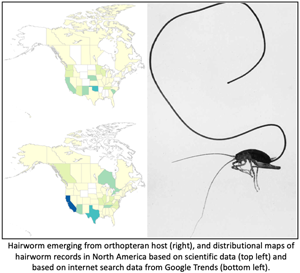Crossref Citations
This article has been cited by the following publications. This list is generated based on data provided by
Crossref.
Doherty, Jean-François
Chai, Xuhong
Cope, Laurie E.
de Angeli Dutra, Daniela
Milotic, Marin
Ni, Steven
Park, Eunji
and
Filion, Antoine
2021.
The rise of big data in disease ecology.
Trends in Parasitology,
Vol. 37,
Issue. 12,
p.
1034.
Cull, Benjamin
2022.
Monitoring Trends in Distribution and Seasonality of Medically Important Ticks in North America Using Online Crowdsourced Records from iNaturalist.
Insects,
Vol. 13,
Issue. 5,
p.
404.
Barahona-Segovia, Rodrigo M.
González, Christian R.
and
Pañinao-Monsálvez, Laura
2022.
Citizen Science Meet South American Tachinids: New Records of Feather-Legged Fly Trichopoda (Galactomyia) pictipennis Bigot (Diptera: Tachinidae) from Chile.
Neotropical Entomology,
Vol. 52,
Issue. 2,
p.
227.
Doherty, Jean-François
and
Poulin, Robert
2022.
Come with me if you want to live: sympatric parasites follow different transmission routes through aquatic host communities.
International Journal for Parasitology,
Vol. 52,
Issue. 5,
p.
293.
Szentivanyi, Tamara
and
Vincze, Orsolya
2022.
Tracking wildlife diseases using community science: an example through toad myiasis.
European Journal of Wildlife Research,
Vol. 68,
Issue. 6,
Barahona-Segovia, Rodrigo M.
Durán-Sanzana, Vanessa
and
Murúa, Maureen
2023.
This flower is our bed: long-term citizen science reveals that hummingbird flies use flowers with certain shapes as sleeping places.
Arthropod-Plant Interactions,
Vol. 17,
Issue. 1,
p.
1.
Windsor, Fredric M.
van den Hoogen, Johan
Crowther, Thomas W.
and
Evans, Darren M.
2023.
Using ecological networks to answer questions in global biogeography and ecology.
Journal of Biogeography,
Vol. 50,
Issue. 1,
p.
57.
Cassini, Rudi
Bruschi, Fabrizio
Frangipane di Regalbono, Antonio
and
Rinaldi, Laura
2023.
Parasitological transitions: selected outcomes from the XXXII Congress of the Italian Society for Parasitology.
Parasitology,
Vol. 150,
Issue. 12,
p.
1077.
Rolfes, Jon W.
and
Godfrey, Stephanie S.
2024.
Seasonal and spatial patterns of infestation with ectoparasitic mites on New Zealand geckos revealed using a crowd‐sourced citizen science database.
Austral Ecology,
Vol. 49,
Issue. 2,
Porras-Silesky, Catalina
Solano-Barquero, Alberto
Jiménez-Rocha, Ana
Alvarado-Hidalgo, Irene
Valverde-Altamirano, Érika
and
Rojas, Alicia
2024.
Social media as a tool for detecting underdiagnosed parasitic infections: the case of spirocercosis.
Parasitology Research,
Vol. 123,
Issue. 1,
Pernat, Nadja
Canavan, Susan
Golivets, Marina
Hillaert, Jasmijn
Itescu, Yuval
Jarić, Ivan
Mann, Hjalte M. R.
Pipek, Pavel
Preda, Cristina
Richardson, David M.
Teixeira, Heliana
Vaz, Ana Sofia
and
Groom, Quentin
2024.
Overcoming biodiversity blindness: Secondary data in primary citizen science observations.
Ecological Solutions and Evidence,
Vol. 5,
Issue. 1,
Chlabicz, Małgorzata
Nabożny, Aleksandra
Koszelew, Jolanta
Łaguna, Wojciech
Szpakowicz, Anna
Sowa, Paweł
Budny, Wojciech
Guziejko, Katarzyna
Róg-Makal, Magdalena
Pancewicz, Sławomir
Kondrusik, Maciej
Czupryna, Piotr
Cudowska, Beata
Lebensztejn, Dariusz
Moniuszko-Malinowska, Anna
Wierzbicki, Adam
and
Kamiński, Karol A
2024.
Medical Misinformation in Polish on the World Wide Web During the COVID-19 Pandemic Period: Infodemiology Study.
Journal of Medical Internet Research,
Vol. 26,
Issue. ,
p.
e48130.
de Groot, Michiel D.
Christou, Maria
Pan, Jeffrey Y.
Adriaens, Tim
Maes, Dirk
Martinou, Angeliki F.
Roy, Helen E.
Verbeken, Annemieke
and
Haelewaters, Danny
2024.
Beetlehangers.org: harmonizing host–parasite records of Harmonia axyridis and Hesperomyces harmoniae.
Arthropod-Plant Interactions,
Vol. 18,
Issue. 4,
p.
665.
Hasegawa, Ryota
Uemura, Yohsuke
Yamashita, Yasunori
Inoshita, Makoto
and
Koizumi, Itsuro
2025.
Highly Threatened Status for the Relict Populations of Ectoparasitic Copepod Salmincola californiensis in Japan.
Aquatic Conservation: Marine and Freshwater Ecosystems,
Vol. 35,
Issue. 2,
